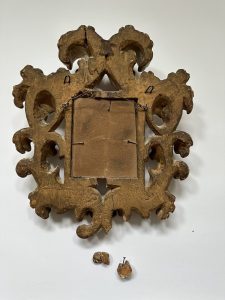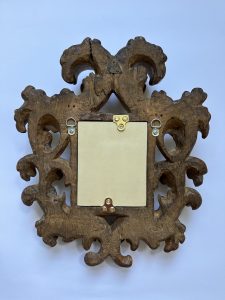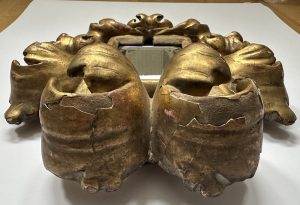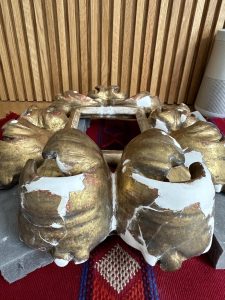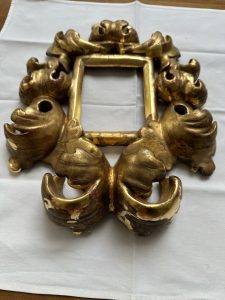Cauliculi frame
Category: Furniture


Introduction
This Cauliculi frame belongs to a private collector. It was a carved and water-gilded frame, likely from the 19th century. It was made of a hardwood, possibly oak.
Condition Before Treatment
The structure was unstable, with a crack running across the entire frame—on the top sight edge and bottom foliage. The top ornament was also mobile, with a visible crack at the back. A corroded fitting located above this crack suggested an older repair. Detached fragments were present on the sight edge and bottom foliage, available to be re-adhered. The surface exhibited active flaking of the gilded layer, with losses to the gesso particularly affecting the top ornaments. A soiling layer was present across the entire frame. The bottom sight edge and an area on the top ornaments showed exposed gesso, indicating overcleaning and removal of the gold layer. The mirror lacked protection at the back and was held in place by three nails, while a fourth nail was found attached to a detached fragment.
Treatment
The front and back of the frame were cleaned using a soft brush to remove heavy soiling, followed by cotton swabs dampened with white spirit. Consolidation was carried out with rabbit skin glue at a 1:10 ratio in water. Flaking gesso was filled using gesso putty made from whiting mixed with rabbit skin glue in the same ratio. Gilding was completed with 23.5 carat Italian Manetti gold leaf supplied by Gold Leaf Supplies. Inpainting and toning were done with watercolours. Black felt tape was applied to line the rebate, provide new slips, and add cushioning. Balsa wood was used as spacers. Brass picture hanging plates (25 mm) served as backboard fittings, and D-ring screws were installed for hanging. Detached fragments were reattached using hide glue. The mirror was cleaned with methylated spirit (alcohol). The top area of the inner back frame was reconstructed using balsa wood and wood filler to protect the mirror. Old fittings were removed, and the remaining corroded metal fitting was mechanically cleaned with a stiff brush and coated with Paraloid B72 in acetone to prevent further corrosion. A new backboard was cut to protect the mirror; two sheets of 2 mm plywood were glued together to match the level of the inner frame.
